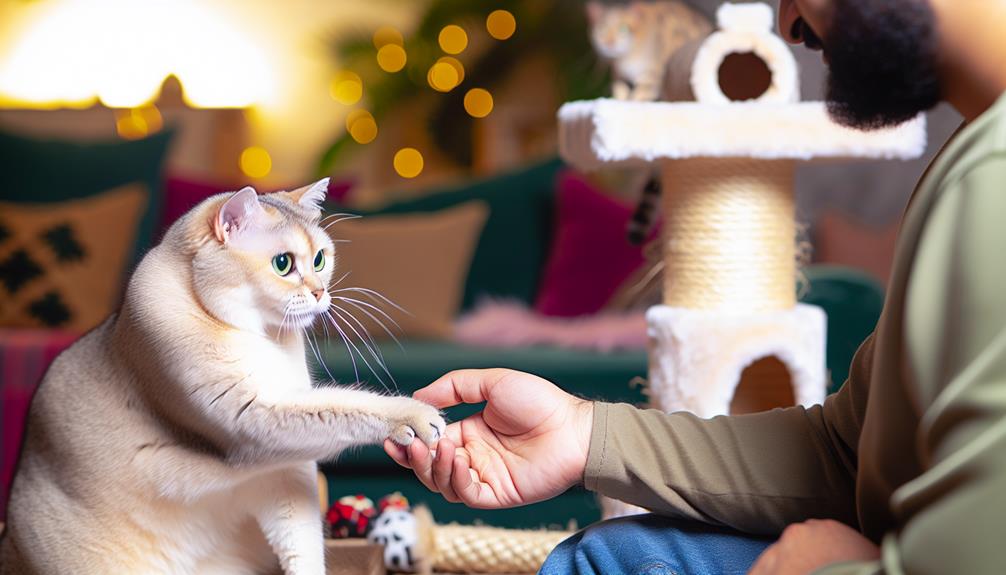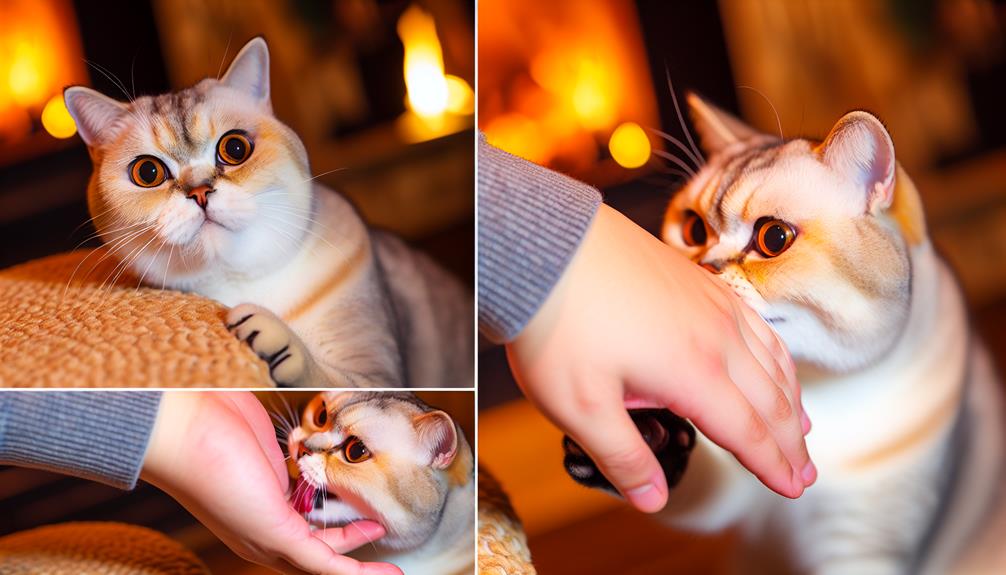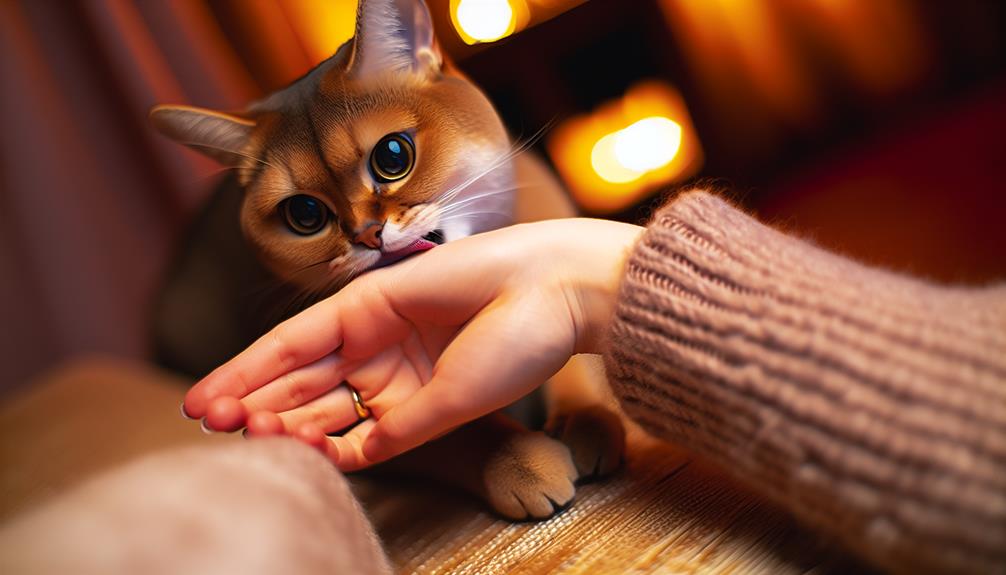Ever wondered why your cat licks you only to follow it up with a bite? It's a perplexing mix of signals, isn't it? This behavior can be rooted in various reasons, ranging from showing affection and engaging in bonding rituals to experiencing overstimulation or simply wanting to play. Cats use a combination of grooming and gentle bites to communicate their needs and feelings, but understanding exactly what's behind these actions can be a bit tricky. Curious about what your feline friend might be trying to tell you? Let's explore the nuances of this intriguing cat behavior.
Affection and Bonding
Understanding the intricacies of feline behavior, particularly the combination of licking and biting, can shed light on their methods of affection and bonding. Cats have a unique way of expressing their feelings, and these actions are deeply rooted in their natural instincts and social structures. When your cat licks you, it's an act of grooming, which is a fundamental part of cat communication and signifies trust and affection. Grooming is a behavior they learn from their mothers and siblings, and it serves to strengthen social bonds within a group.
The subsequent bite can be equally significant in understanding feline affection. In many cases, this behavior is a gentle nibble rather than an aggressive chomp. This nibbling is often a playful gesture or a way to keep the grooming session dynamic. Cats use a combination of licking and biting not just with their human companions but also with other cats, as a way to maintain their social relationships. It's a nuanced form of communication that conveys a sense of closeness and mutual grooming.
Moreover, cats may lick and then bite as a way to interact and engage with you. This behavior can be a method of initiating play or signaling that they want your attention. It's crucial to observe the context and the overall body language of your cat to interpret these actions accurately. Understanding these subtle cues in cat communication will help you better appreciate the depth of feline affection and strengthen the bond you share with your pet.
Overstimulation
When it comes to feline behavior, overstimulation can be a key factor behind the seemingly contradictory actions of licking followed by biting. Cats have sensitive nerve endings in their skin, and prolonged petting or handling can lead to sensory overload. This overstimulation can manifest in abrupt changes in their behavior, such as a sudden bite following a period of affectionate licking.
Understanding your cat's body language is essential to prevent overstimulation. Cats will often give subtle hints that they're reaching their threshold. These signals might include twitching tails, flattened ears, or dilated pupils. Recognizing these signs early can help you avoid pushing your cat into a state of sensory overload.
Here are four steps to manage and prevent overstimulation in your cat:
- Observe and Learn: Pay close attention to your cat's body language. Each cat has unique tolerance levels, and recognizing when they're becoming overstimulated can prevent bites.
- Limit Petting Sessions: Keep petting sessions short and sweet. Regular breaks can prevent sensory overload and keep interactions positive.
- Offer Alternatives: Provide toys and scratching posts to channel their energy and reduce the need for constant physical interaction.
- Create a Calming Environment: guarantee your cat has a quiet space to retreat to when they feel overwhelmed. A calm environment can reduce the likelihood of overstimulation.
Play Behavior

Play behavior in cats is another common reason you might observe the combination of licking followed by biting. This behavior often reflects their innate hunting instincts, which are deeply ingrained from their wild ancestors. When your cat engages in play, they frequently mimic the actions they would use in hunting. Licking can be interpreted as a form of affectionate grooming, but it can quickly shift into a playful bite as part of their pretend "hunt."
In the wild, cats go through a sequence of stalking, pouncing, biting, and finally, grooming their prey. Even though your domestic cat doesn't need to hunt for survival, these behaviors are hardwired into their DNA. By licking you, your cat might be signaling the start of a playful interaction. The subsequent bite could be their way of simulating the capture of prey.
Moreover, social hierarchy plays a significant role in this behavior. Cats use play to establish and reinforce social bonds and hierarchies within their group. When your cat licks and then bites you, they could be asserting their position in the social structure of your household. This behavior can sometimes be a test of boundaries, determining how you respond to their playful advances.
Understanding this behavior can help you manage it more effectively. Offering alternative outlets for their hunting instincts, like interactive toys, can divert their playful biting away from your skin. Likewise, recognizing the signs that your cat is shifting from licking to playful biting allows you to redirect their attention before it becomes uncomfortable. This way, you can maintain a harmonious and enjoyable relationship with your feline friend.
Grooming Instincts
Your cat's grooming instincts are another key reason behind the behavior of licking followed by biting. Cats are naturally inclined to groom themselves and their companions, a behavior rooted deeply in their feline instincts. When your cat licks you, it's often a display of affection and a way to bond, much like how they would groom another cat. However, the subsequent bite can be baffling but is actually part of this intricate grooming behavior.
Here are some detailed reasons why your cat might lick and then bite you:
- Overstimulation: During grooming sessions, cats can sometimes get overstimulated. After a period of licking, they might bite to signal that they've had enough or to create a break in the activity. This biting isn't aggressive but more of a communication tool.
- Mimicking Cat-to-Cat Grooming: Cats groom each other by licking and occasionally nipping, especially when dealing with tough spots like mats or tangles in their fur. When your cat licks and bites you, it might be mimicking this social grooming behavior, treating you as part of their feline family.
- Instinctual Behavior: In the wild, grooming can serve multiple purposes, such as removing parasites. The combination of licking and biting helps in cleaning more effectively. Your domesticated cat's actions are driven by these same inherent instincts.
- Territorial Marking: When a cat licks you, they're depositing their scent on you, effectively marking you as part of their territory. The bite that follows could be a gentle reminder of this bond and their claim over you.
Understanding these aspects of your cat's grooming behavior can help you better appreciate their actions and strengthen your bond with your feline friend.
Attention-Seeking

Cats are masters at seeking attention, and their behavior of licking followed by biting can be a clear indication of this. When your cat engages in this pattern, it's often a form of cat communication designed to capture your focus. Licking can start as a gentle, affectionate gesture, but if followed by a bite, it might signal that your cat wants more interactive engagement from you.
Understanding these behavioral signals is vital. Cats don't have the same verbal communication skills as humans, so they rely on actions to convey their needs and emotions. The shift from licking to biting can be your cat's way of saying, "Pay attention to me!" This behavior is especially common in cats that feel their social needs aren't being met. They might be bored, lonely, or simply craving more of your time and affection.
It's important to observe the context in which this behavior occurs. If your cat licks and then bites during petting sessions, they might be trying to prompt you to keep petting or to modify your technique. Alternatively, if this happens when you're preoccupied with something else, it might be a more direct demand for attention.
Responding appropriately to these behavioral signals can help strengthen your bond with your cat. Offer interactive play sessions, introduce new toys, or simply spend more quality time with them. By doing so, you not only meet their attention-seeking needs but also reinforce positive behaviors. Recognizing these subtle cues in cat communication promotes a happier, more harmonious relationship between you and your feline friend.
Conclusion
So, when your cat licks you and then bites, it's a whirlwind of love, overstimulation, playful antics, grooming instincts, and a cry for attention—all rolled into one furry package! Your feline friend's complex communication is a reflection of their intricate nature. By paying close attention to their signals, you're not just avoiding a nip; you're deepening a bond that's richer, more nuanced, and utterly fascinating. Embrace these moments—they're the essence of cat companionship!
